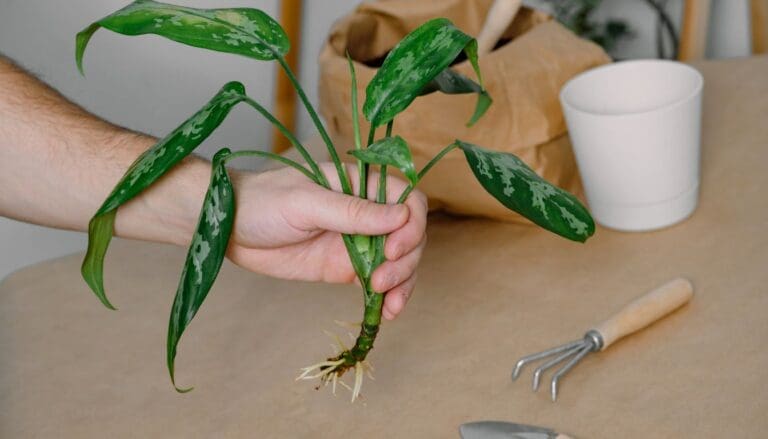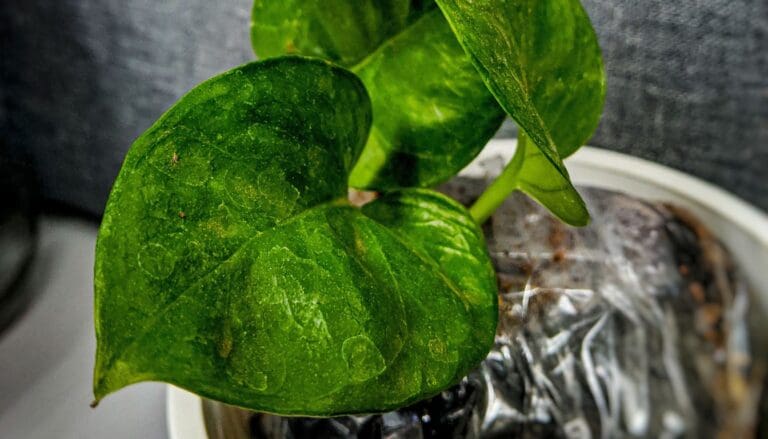How To Prune Chinese Evergreen? (Step-by-Step Guide)
Chinese evergreen plants are popular houseplants found in homes and offices. Since Chinese evergreens are low-maintenance plants, they don’t require frequent pruning.
A Chinese evergreen will only require pruning when you find it leggy, or you notice dead and damaged parts on it.
So, in this article, we shall learn all about pruning a Chinese evergreen plant.
Here are the steps you need to follow to prune a Chinese evergreen plant:
- Inspect the plant for leggy, unwanted, or wilted growth.
- Use a sterilized pair of clippers to clip any yellow, brown, or leggy growth.
- Please keep in mind that you need to prune near the base of the main stem.
- Remove any dead parts.
- Clip about 15-25% of total foliage.
- Water the plant and move them to a brightly lit spot.
You should be careful while pruning the plant, as any mistake can damage it severely.
This article will explain pruning a Chinese evergreen plant without making a mistake. You will also know how to understand that your Chinese evergreen requires pruning and the best time to do it.

Please note: Simplify Plants is reader-supported. Some links in the post are affiliate links and I get a commission from purchases made through links in the post.
Signs that show your Chinese Evergreen plant needs pruning
Before you learn how to prune your Chinese evergreen, let’s understand how to identify a Chinese evergreen that requires pruning.
Leggy growth
Chinese evergreen doesn’t demand a lot of pruning, but if you notice that the stems are growing long and thin, you will need to prune those parts as they won’t become healthy.
Removing these parts and providing the ideal growing conditions to the plant will allow it to focus on new and healthy growth.
Discolored leaves

Yellow or brown leaves are often signs of some internal problems. You need to inspect the plant and identify the problem, but you also need to remove these leaves.
Some leaves may get discolored at the end of their life cycle. If you notice such leaves on your Chinese evergreen, you must prune them.
Also read:
- Why Are My Chinese Evergreen Leaves Turning Yellow (Causes+Fix)
- Why Is My Chinese Evergreen Turning Brown? (Possible Problems+Fix)
Root rot
Overwatering leads to root rot. If you get a foul smell from the soil, you need to inspect the roots, and if you notice that they have turned brown and mushy, it indicates that the plant is experiencing root rot.
You must take a pruner and prune such roots right away and leave the healthy roots behind. After this, you need to repot your Chinese evergreen to treat the root rot disease.
Also read: How Do You Save An Overwatered Chinese Evergreen? (Signs, Causes & Fix)
Pest Infestation
Chinese evergreen doesn’t attract pests much. But if it does, you will notice that certain parts have a lot of pests, and you need to prune those off.
You need to spray a neem oil solution or use an insecticide to remove the pests, but the parts that are heavily infested are better be pruned as these parts can affect other healthy parts.
Also read: Do Chinese Evergreen Get Bugs? (Common Bugs+How To Get Rid Of Them)
What is the best time to prune a Chinese evergreen?
The ideal time to prune any plant is during its growing season. Pruning during the growing season results in faster recovery and growth.
Spring and summer are the growing seasons of a Chinese evergreen plant. These are tropical plants and grow best when the conditions are warm.
Many people prune the blooms of the Chinese evergreen to encourage more foliage growth. This species blooms during summer and spring, and therefore, you can prune the flowers along with the dead or damaged foliage.
While trimming your Chinese evergreen, make sure you don’t chop off the healthy and growing ends. Cutting down those parts can restrict the growth of your plant. At the same time, deep cuts can kill it too.
Tools needed to prune a Chinese evergreen
For successful pruning, you need some equipment. Before beginning the process, gather these tools in your workplace.
A pair of sharp scissors or pruner: Sharp tools will ensure that you make clean cuts on your Chinese evergreen plant.
Disinfectant: Disinfecting the tools before and after use will help avoid pest infestations and fungal or bacterial growth.
A pot: If you take a healthy cutting while pruning, you can use it to propagate the Chinese evergreen.
Gloves: Since the Chinese evergreen is a toxic plant, you should wear gloves while pruning it.
How to prune Chinese evergreen plants?
Prune all the dead and damaged leaves or leggy branches that you find on your Chinese evergreen plant. Here’s how you can prune your Chinese evergreen.
1. Inspect your Chinese evergreen
First, you need to inspect your Chinese evergreen thoroughly and find out which parts you want to or need to prune.
These can be the leggy parts that have grown too long and slim and have very few leaves on them. These can also be damaged branches that will not grow further.
You must also prune all the foliage that makes the Chinese evergreen look crowded or the discolored and diseased leaves.
2. Prune the plant
Once you have identified the parts you want to get rid of, take the pruners and disinfect them. Be careful while pruning to avoid losing young, healthy leaves and branches.
Cut the leaves of the plant, probably about three to four inches below, which will allow the new leaves to grow.
Try to avoid deep cuts. Primarily focus on the damaged leaves.
Prune at the base of the plant as new growth appears from the crown of a Chinese evergreen. Avoid making cuts on the upper surfaces and go deep inside the plant while pruning.
3. Prune the blooms
You can prune the flowers as they utilize a lot of nutrition and water from the xylem. If you prune the blooms, the plant will grow more leaves.
The blooms of a Chinese evergreen don’t look as good as the foliage so pruning them should not be a problem.
4. Prune 20-25% of the plant
Since pruning puts the plant through some stress, you must not prune a lot of the plant at once, which will induce excess stress on the plant.
Therefore, you must prune 20-25% of the Chinese evergreen to not stress it too much at once.
Now that you understand how to prune your Chinese evergreen plant, you can use a healthy branch to propagate the plant instead of throwing it away.
How to propagate a Chinese evergreen from a pruned stem?

After taking a stem cutting from your Chinese evergreen plant, you can either put it in the soil or water to propagate it.
To ensure successful propagation, you must ensure that the stem cutting is healthy and taken from a mature Chinese evergreen.
If you go for water propagation, you can take a glass jar, fill it with clean water, and put the stem inside it. You can add some water-soluble fertilizer to the water to provide nutrients.
Take a small pot, add some peat-based soil, and place the stem in the soil in soil propagation. Before putting the stem inside the pot, add some rooting hormone.
You should keep the soil moist and provide enough humidity to allow the cutting to grow fast.
Wait for a few weeks and provide sufficient sunlight, temperature, and humidity to let the cuttings grow roots. After the roots come out, you can shift the new plant to a new pot with a well-draining soil mix.
How to take care of Chinese evergreen plants after pruning?
Chinese evergreen plants make your home a better place to live in with their beautiful leaves and purifying the air. After pruning the plant, you must let it recover by taking proper care.
Here are a few essential care tips to help your Chinese evergreen recover and thrive.
- Keep the Chinese evergreen in a bright area with ample indirect sunlight. Avoid exposing the Chinese evergreen to direct sunlight.
- You can keep the Chinese evergreen in your office as it can tolerate low-light environments and do well under artificial lights.
- The Chinese evergreen will need more sunlight if the plant’s leaves’ variegation is more. Similarly, it will need less sunlight if the variegation is less.
- Try to maintain temperatures between 68-77°F. Protect the plant from low temperatures during winter.
- Try to provide high humidity with the help of a humidifier, and don’t let the humidity levels drop below 50%, as the plant will start showing problems.
- Chinese evergreens prefer a moist soil so use a potting mix that retains the required moisture and drains the excess.
- Water the plant once in 7-10 days only if the top layers of the soil feel dry. Don’t overwater or underwater your Chinese evergreen.
- Chinese evergreens are light feeders so fertilize them with a diluted dose of a balanced fertilizer only during the growing season. Avoid fertilizing in winter.
- Spray neem oil on the plant once a month as prevention against pesky pests.
- Avoid exposing the plant to heating sources such as fireplaces, furnaces, radiators, etc., as these can burn the leaves and dehydrate the plant.
- Chinese evergreen is sensitive to hot and cold drafts, so keep it away.
- Chinese evergreen contains calcium oxalate crystals that make it toxic, so you must keep the plant away from the reach of your children and pets.
Final words

Chinese evergreen is a tolerant and low-maintenance plant that doesn’t demand much. It can do well with little care and attention.
Like most houseplants, Chinese evergreens don’t call for regular pruning, and you need to prune it only when it is absolutely required.
You must prune your Chinese evergreen to remove the plant’s dead, damaged, and unnecessary parts.
Pruning the blooms also helps as the plant can then focus on growing new leaves, and since the blooms are not very attractive, pruning them doesn’t cause heartbreak.
You must prune the Chinese evergreen and make precise cuts with sterilized pruners during its growing season. Pruning near the center of the plant prevents damaging cuts and encourages new growth.
If you plan to prune your Chinese evergreen, try to do it during spring if not urgent.
You can propagate the healthy stems you prune to get new Chinese evergreen plants. Take proper care of the plant after pruning it to let it recover and show new growth faster.
Reference: Wikipedia, Nasa clean air study, Missouri Botanical Garden, The University of Kansas, NC State University.
Recommended Garden Supplies
| Product Image | Our Recommended Gardening Supplies | Check Offers! |
|---|---|---|
Top Top
Top
Top
Top
Top
Top
Top
Top | rePotme Houseplant and Tropical Classic Potting Soil Mix | Check Offer On Amazon |
 Top
Top
Top
Top
Top
Top
Top
Top | Espoma Organic Indoor Plant Food | Check Offer On Amazon |
 Top
Top
Top
Top
Top
Top
Top
Top | GooingTop LED Grow Light 6000K Full Spectrum Clip Plant Growing Lamp | Check Offer On Amazon |
 Top
Top
Top
Top
Top
Top
Top
Top | Soil Moisture Meter | Check Offer On Amazon |
 Top
Top
Top
Top
Top
Top
Top
Top | Govee Hygrometer Thermometer, Bluetooth Enabled! | Check Offer On Amazon |
 Top
Top | LEVOIT Humidifiers for Large Room(Best For Plants) | Check Offer On Amazon |
 Top
Top
Top
Top
Top
Top
Top
Top | Upgraded DIY Automatic Drip Irrigation Kit, 15 Potted Houseplants Support | Check Offer On Amazon |
 Top
Top
Top
Top
Top
Top
Top
Top | Stainless Steel Heavy Duty Gardening Tool Set | Check Offer On Amazon |
 Top
Top
Top
Top
Top
Top
Top
Top | Bonide Insecticidal Soap | Check Offer On Amazon |
 Top
Top
Top
Top
Top
Top
Top
Top | Bonide 32 oz Spray Neem Oil for Organic Gardening | Check Offer On Amazon |
 Top
Top
Top
Top
Top
Top
Top
Top | Garden Safe Fungicide | Check Offer On Amazon |








